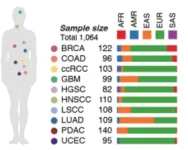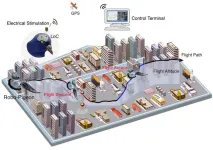(Press-News.org) The immune system must be able to quickly attack invaders like viruses, while also ignoring harmless stimuli, or allergies can result. Immune cells are known to ignore or “tolerate” molecules found on the body’s own healthy cells, for instance, as well as nonthreatening substances from outside the body like food. How the system achieves the latter has been unclear.
Now, a new study led by researchers at NYU Langone Health has revealed that a special group of cells in the intestines tamp down the immune responses caused by exposure to food proteins. Called “tolerogenic dendritic cells,” these cells enable food to pass through the body without triggering an immune reaction, unless they malfunction to cause allergies.
The cells were also found to require the proteins Retinoic Acid-Related Orphan Receptor-gamma-t (RORγt) and PR domain-containing 16 (Prdm16) to effectively protect tolerated proteins from the inrush of immune cells and proteins meant to destroy foreign cells (inflammation). Without properly functioning tolerogenic dendritic cells, mice in the study were more prone to develop food allergies and asthma.
Previous work by the team had revealed that these same cells control immune tolerance to friendly gut bacteria, which help humans to digest food and to control functions of multiple organ systems. But at the time, the researchers knew little about their identity or whether these cells controlled tolerance to anything else.
“Our study shows that RORγt-expressing dendritic cells are key components in the immune regulatory response that prevents food allergies,” said study senior author Dan Littman, MD, PhD, the Helen L. and Martin S. Kimmel Professor of Molecular Immunology in the Department of Pathology, and a professor in the Department of Cell Biology, at NYU Grossman School of Medicine.
“This discovery adds evidence to our earlier work showing that these cells also keep the peace with the vast microbiome, the mix of microbes that inhabits our body, and may be important for preventing autoimmune conditions like Crohn’s disease,” said Littman, who is also a Howard Hughes Medical Institute Investigator.
By analyzing the genes and proteins these cells express and comparing them to well-understood cell types, the researchers concluded that they are a type of immune cell called a dendritic cell. Typically, dendritic cells present tiny fragments of biological material (known as antigens) for notice by other immune cells called T cells. This programs the T cell to launch an immune attack the next time it encounters the antigen.
But the researchers showed that when the tolerogenic dendritic cells present antigens from food or friendly microbes to T cells, the T cells become anti-inflammatory, or “regulatory.” This means that the next time that the T cell encounters the antigen, instead of attacking, it will suppress nearby inflammation.
Publishing in the journal Nature online April 14, the study showed that in mice without tolerogenic dendritic cells, there were fewer regulatory T cells ready to prevent inflammation caused by food or microbial antigens. Those mice also had more inflammatory T cells that caused allergies and inflammation when exposed to those antigens.
Another key finding from the paper was that by analyzing human intestinal tissue and public sequencing datasets, the researchers found the human equivalents of tolerogenic dendritic cells. Littman says it is not yet clear how abundant these cells are inside the human body or whether they are involved in other forms of immune tolerance outside the intestines. But those questions should be easier to answer because of how comprehensively the researchers identified the cells in the new study.
“If further experiments prove successful, our findings could lead to innovative ways to treat food allergies,” said Littman. “For example, if someone has a peanut allergy, perhaps we can use tolerogenic dendritic cells to help create more regulatory T cells to suppress an allergic response to peanut molecules.”
Moving forward, Littman said the researchers also want to more deeply understand how and where tolerogenic dendritic cells develop in the body and what kinds of signals they need to receive to perform their function.
Funding support for this study was provided by National Institutes of Health grants P30CA016087, R01AI158687, T32AL100853, F32AI181496, and K08CA283272.
In addition to Littman, other NYU Langone researchers involved in this study include co-first authors Liuhui Fu, Rabi Upadhyay, Maria Pokrovskii; and co-authors Francis Chen, Gabriela Romero-Meza, Adam Griesemer.
Littman is a co-founder of Vendanta Biosciences and ImmunAI, and serves on the advisory boards of IMIDomics, Sonoma Biotherapeutics, NILO Therapeutics, and Evommune, and on the board of directors of Pfizer Inc.
None of these groups were involved in the current study. The terms and conditions of these relationships are being managed in accordance with the policies and procedures of NYU Langone Health.
Media Inquiries
David March
212-404-3528
David.March@NYULangone.org
STUDY DOI
10.1038/s41586-025-08982-4
STUDY LINK WILL BECOME ACTIVE AFTER EMBARGO LIFTS
https://www.nature.com/articles/s41586-025-08982-4.
END
Recently discovered immune cell type is key to understanding food allergies
2025-04-14
ELSE PRESS RELEASES FROM THIS DATE:
Projected lifetime cancer risks from current computed tomography imaging
2025-04-14
About The Study: This study found that at current utilization and radiation dose levels, computed tomography examinations in 2023 were projected to result in approximately 103,000 future cancers over the course of the lifetime of exposed patients. If current practices persist, computed tomography-associated cancer could eventually account for 5% of all new cancer diagnoses annually.
Corresponding Author: To contact the corresponding author, Rebecca Smith-Bindman, MD, email rebecca.smith-bindman@ucsf.edu.
To access the embargoed study: Visit our For The Media website at this link https://media.jamanetwork.com/
(doi:10.1001/jamainternmed.2025.0505)
Editor’s ...
Incidence of pancreas and colorectal adenocarcinoma in the US
2025-04-14
About The Study: The findings of this cohort study suggest that the incidence of pancreatic adenocarcinoma has increased among all age groups, whereas that of colorectal adenocarcinoma has increased among younger age groups. Clinicians should be aware of this trend when evaluating younger patients with relevant symptoms.
Corresponding Author: To contact the corresponding author, Arvind J. Trindade, MD, email arvind.trindade@gmail.com.
To access the embargoed study: Visit our For The Media website at this link https://media.jamanetwork.com/
(doi:10.1001/jamanetworkopen.2025.4682)
Editor’s Note: Please see the article for additional ...
Gestational age and cognitive development in childhood
2025-04-14
About The Study: In this cross-sectional study of children ages 9 to 10, moderately preterm birth was associated with long-term cognitive problems independent of socioeconomic status, genetics, and other risk factors. These findings underscore the need for continued follow-up of all preterm children, with particular focus on those born before 34 weeks’ gestational age, because they may face greater developmental challenges over time.
Corresponding Author: To contact the corresponding author, Samson Nivins, PhD, email samson.nivins@ki.se.
To ...
Study reveals how inherited genes help shape the course of cancer
2025-04-14
New York, NY [April 14, 2025]—A new multicenter study by researchers at the Icahn School of Medicine at Mount Sinai, in collaboration with the National Cancer Institute-funded Clinical Proteomic Tumor Analysis Consortium (CPTAC) and colleagues around the world, has discovered that the genes we are born with—known as germline genetic variants—play a powerful, underappreciated role in how cancer develops and behaves.
Published in the April 14 online issue of Cell [https://doi.org/10.1016/j.cell.2025.03.026], the study is the first to detail how millions of inherited genetic differences influence the activity of thousands of proteins within tumors. Drawing on data ...
UC Berkeley analysis finds steep increase of self-harm among California girls, multiracial youth
2025-04-14
The number of California teens who have been treated for self-harm has ballooned in recent years, with an especially concerning increase among multiracial girls, according to new research from the University of California, Berkeley, published today (Monday, April 14) in JAMA Pediatrics.
Using data from California emergency departments and inpatient care facilities from 2005 to 2021 — 231,232 reports in total — researchers examined both how the rate of annual nonfatal self-harm incidents has changed, as well as rate differences based on age, sex, and race and ethnicity.
The study ...
Study sheds light on how inherited cancer mutations drive tumor growth
2025-04-14
Most cancer genome studies have focused on mutations in the tumor itself and how such gene variants allow a tumor to grow unchecked. A new study, led by researchers at Washington University School of Medicine in St. Louis, takes a deep dive into inherited cancer mutations measured in a healthy blood sample and reports how those mutations might take a toll on the body’s cells starting at birth, perhaps predisposing a person to develop cancers at various stages of life.
The authors analyzed the inherited genomes of more than 1,000 cancer patients and determined how inherited mutations — ...
Popular CT scans could account for 5% of all cancer cases a year
2025-04-14
Popular CT Scans Could Account for 5% of All Cancer Cases A Year
Radiation from imaging could lead to lung, breast and other future cancers, with 10-fold increased risk for babies
CT scans may account for 5% of all cancers annually, according to a new study out of UC San Francisco that cautions against overusing and overdosing CTs.
The danger is greatest for infants, followed by children and adolescents. But adults also are at risk, since they are the most likely to get scans.
Nearly 103,000 cancers are predicted to result from the 93 million CTs that were ...
Deep-sea mining risks leads study to urge shift to circular solutions
2025-04-14
Deep-sea mining (DSM) not only poses significant environmental, social, and economic risks that may have far-reaching implications for coastal communities and Small Island Developing States (SIDS), it is also likely to negatively affect the business community, including insurers and investors, says a new study by researchers from the University of British Columbia and the Dona Bertarelli Philanthropy.
DSM operations are expected to increase the negative impact on environmental indicators by up to 13 per cent, a change categorized as having “great” significance, relative to the “without” DSM scenario, ...
Dynamically controlled flight altitudes in robo-pigeons via locus coeruleus neurostimulation
2025-04-14
Background
Robo-pigeon / Cyborg pigeon is a new type of hybrid intelligent robotic system developed by combining micro-implantable brain-computer interface (BCI) and micro-electro-mechanical system (MEMS) technologies. By integrating the perception, motion and autonomous intelligence of real pigeons with the high precision, repeatability and controllability of MEMS, a flexible and efficient "biological flight platform" is formed, which has a broad application prospect in key fields such as disaster rescue, national defense security and environmental monitoring.
However, ...
Using AI to monitor inaccessible locations of nuclear energy systems
2025-04-14
Whether it’s for your vehicle or your home, from small-scale uses to the largest, the debate over the most efficient and cost-effective fuels continues. Currently, there’s no shortage of options either.
Nuclear power provides an alternative to more conventional energy options but requires rigorous systems monitoring and safety procedures. Machine learning could make keeping a close eye on key elements of nuclear systems easier and response time to issues faster.
Syed Bahauddin Alam, an assistant professor ...


